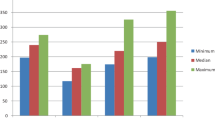Abstract
The only technique available for creating an intestinal anastomosis without tissue strangulation is gluing. Theoretically, this could lead to a higher hydroxyproline content and greater mechanical strength than in a sutured anastomosis. To test the hypothesis, 83 rats underwent left colon resection and inverted primary anastomosis with either one layer of sutures (NG group) or fibrin glue (FG group). Seven-day FG anastomoses showed less adhesions (P=.02) but one subclinical leakage and a further radiologic one, compared with a greater amount of adhesions but no leakages in the NG group. The mean bursting pressures (mmHg) in the FG and NG groups, respectively, were 25±20 (SD) and 63±23 (N.S.) 30 minutes after surgery, 107±33 and 115±30 after one day, 81±31 and 133±26 (P<.001) after four days, and 161±36 and 175±24 after seven days. The somewhat earlier rise in hydroxyproline content in the glued anastomoses did not lead to significant intergroup differences. The glued anastomoses were thus weak during the critical lag period of healing. Also, by preventing adhesion formation, the glue may reduce the extra blood supply from perianastomic vessels. The outcomes might have differed more under demanding experimental or clinical situations.
Similar content being viewed by others
References
Cronin K, Jackson DS, Dunphy JE. Changing bursting strength and collagen of the healing colon. Surg Gynecol Obstet 1968;126:747–53.
Ballantyne GH. Intestinal suturing: review of the experimental foundations for traditional doctrines. Dis Colon Rectum 1983; 26:836–43.
Zederfeldt B. Factors influencing wound healing. In: Viidik A, Vuust J, eds. Biology of collagen. London: Academic Press, 1980:347–62.
Ballantyne GH. The experimental basis of intestinal suturing: effect of surgical technique, inflammation, and infection on enteric wound healing. Dis Colon Rectum 1984;27:61–71.
Graffner H, Andersson L, Löwenhielm P, Walther B. The healing process of anastomoses of the colon: a comparative study using single, double-layer or stapled anastomosis. Dis Colon Rectum 1984;27:767–71.
Ballantyne GH, Burke BJ, Rogers G, Lambert EG, Boccia J. Accelerated wound healing with stapled enteric suture lines: an experimental study comparing traditional sewing techniques and a stapling device. Ann Surg 1985;201:360–4.
Steichen FM, Ravitch MM. History of mechanical devices and instruments for suturing. Curr Probl Surg 1982;19:1–51.
Hardy TG Jr, Pace WG, Maney JW, Katz AR, Kaganov A. A biofragmentable ring for sutureless bowel anastomosis: an experimental study. Dis Colon Rectum 1985;28:484–90.
Weilbaecher DA, Mathieu FJ, Cohn I Jr. Nonsuture intestinal anastomosis. Am J Surg 1964;107:353–60.
Nordkild P, Hjortrup A, Kjaergaard J. Tissue adhesives and intestinal anastomosis. Ann Chir Gyn 1986;75:205–8.
Kirkegaard P, Christensen AB, Ibsen J, Hegedus V, Christiansen J. Experimental nonsuture colonic anastomoses. Am J Surg 1980;139:233–6.
Scheele VJ, Herzog J, Mühe E. Anastomosensicherung am, Verdauungstrak mit Fibrinkleber. Nahttechnische Guundlagen, experimentelle Befunde, klinische Erfahrungen. Zentralbl Chir 1978;103:1325–36.
Galletti G, Giardino R, Ussia G, Brulatti M, Bellini R, Ruscelli P. Sutureless colon anastomosis employing a tissue adhesive (Tisucol) (abstr). Digestive Surgery 1984;1:128.
Hjortrup A, Nordkild P, Kiaergaard J, Sjntoft E, Olesen HP. Fibrin adhesive versus sutured anastomosis: a comparative intraindividual study in the small intenstine of pigs. Br J Surg 1986;73:760–1.
Kram HB, Garces MA, Klein SR, Shoemaker WC. Common bile duct anastomosis using fibrin glue. Arch Surg 1985;120:1250–6.
Kivirikko KI, Laitinen O, Prockop DJ. Modifications of a specific assay for hydroxyproline in urine. Anal. Biochem. 1967;19:249–55.
Neuman RE, Logan MA. The determination of hydroxyproline. J Biol Chem 1950;184:299–306.
Nelsen TS, Anders CJ. Dynamic aspects of small intestinal rupture with special consideration of anastomotic strength. Arch Surg 1966;93:309–14.
Golden T, Levy AH, O'Connor WT. Primary healing of skin wounds and incisions with a threadless suture. Am J Surg 1962;104:603–14.
Dunphy JE, Jackson DS. Practical applications of experimental studies in the care of the primary closed wound. Am J Surg 1962;104:273–82.
Forrester JC, Zederfeldt BH, Hayes TL, Hunt TK. Tape-closed and sutured wounds: a comparison by tensiometry and scanning electron microscopy. Br J Surg 1970;57:729–37.
Linderberg S, Steentoft P, Sörensen SS, Olesen HP. Studies on prevention of intra-abdominal adhesion formation by fibrin sealant: an experimental study in rats. Acta ChirScand 1985;151: 525–7.
Houdart R, Lavergne A, Valleur P, Villet R, Hautefeuille P. Vascular evolution of single-layer end-on colonic anastomosis. Dis Colon Rectum 1985;28:475–80.
Shandall AA, Williams GT, Hallett MB, Young HL. Colonic healing: a role for polymorphonuclear leucocytes and oxygen radical production. Br J Surg 1986;73:225–8.
Hulkko OA, Haukipuro KA, Laitinen ST. Fibringlue protection of primary anastomosis in the obstructed left colon: an experimental study on the rat. Acta Chir Scand 1988;154:49–52.
Author information
Authors and Affiliations
Additional information
Supported financially by a grant from the Paulo Foundation.
About this article
Cite this article
Haukipuro, K.A., Antero Hulkko, O., Alavaikko, M.J. et al. Sutureless colon anastomosis with fibrin glue in the rat. Dis Colon Rectum 31, 601–604 (1988). https://doi.org/10.1007/BF02556795
Received:
Issue Date:
DOI: https://doi.org/10.1007/BF02556795




